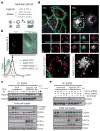EGFR modulates microRNA maturation in response to hypoxia through phosphorylation of AGO2
- PMID: 23636329
- PMCID: PMC3717558
- DOI: 10.1038/nature12080
EGFR modulates microRNA maturation in response to hypoxia through phosphorylation of AGO2
Abstract
MicroRNAs (miRNAs) are generated by two-step processing to yield small RNAs that negatively regulate target gene expression at the post-transcriptional level. Deregulation of miRNAs has been linked to diverse pathological processes, including cancer. Recent studies have also implicated miRNAs in the regulation of cellular response to a spectrum of stresses, such as hypoxia, which is frequently encountered in the poorly angiogenic core of a solid tumour. However, the upstream regulators of miRNA biogenesis machineries remain obscure, raising the question of how tumour cells efficiently coordinate and impose specificity on miRNA expression and function in response to stresses. Here we show that epidermal growth factor receptor (EGFR), which is the product of a well-characterized oncogene in human cancers, suppresses the maturation of specific tumour-suppressor-like miRNAs in response to hypoxic stress through phosphorylation of argonaute 2 (AGO2) at Tyr 393. The association between EGFR and AGO2 is enhanced by hypoxia, leading to elevated AGO2-Y393 phosphorylation, which in turn reduces the binding of Dicer to AGO2 and inhibits miRNA processing from precursor miRNAs to mature miRNAs. We also identify a long-loop structure in precursor miRNAs as a critical regulatory element in phospho-Y393-AGO2-mediated miRNA maturation. Furthermore, AGO2-Y393 phosphorylation mediates EGFR-enhanced cell survival and invasiveness under hypoxia, and correlates with poorer overall survival in breast cancer patients. Our study reveals a previously unrecognized function of EGFR in miRNA maturation and demonstrates how EGFR is likely to function as a regulator of AGO2 through novel post-translational modification. These findings suggest that modulation of miRNA biogenesis is important for stress response in tumour cells and has potential clinical implications.
Conflict of interest statement
The authors declare no competing financial interests.
Figures




Comment in
-
MicroRNA: lacking in maturity.Nat Rev Cancer. 2013 Jun;13(6):377. doi: 10.1038/nrc3534. Epub 2013 May 16. Nat Rev Cancer. 2013. PMID: 23676851 No abstract available.
-
Argonaute regulation: two roads to the same destination.Dev Cell. 2013 Jun 24;25(6):553-4. doi: 10.1016/j.devcel.2013.06.009. Dev Cell. 2013. PMID: 23806615
-
EGFR gets in the way of microRNA biogenesis.Cell Res. 2013 Oct;23(10):1157-8. doi: 10.1038/cr.2013.87. Epub 2013 Jul 9. Cell Res. 2013. PMID: 23835474 Free PMC article.
References
-
- Kim VN. MicroRNA biogenesis: coordinated cropping and dicing. Nature Rev Mol Cell Biol. 2005;6:376–385. - PubMed
-
- van Kouwenhove M, Kedde M, Agami R. MicroRNA regulation by RNA-binding proteins and its implications for cancer. Nature Rev Cancer. 2011;11:644–656. - PubMed
-
- Lu J, et al. MicroRNA expression profiles classify human cancers. Nature. 2005;435:834–838. - PubMed
-
- Pouysségur J, Dayan F, Mazure NM. Hypoxia signalling in cancer and approaches to enforce tumour regression. Nature. 2006;441:437–443. - PubMed
Publication types
MeSH terms
Substances
Grants and funding
LinkOut - more resources
Full Text Sources
Other Literature Sources
Molecular Biology Databases
Research Materials
Miscellaneous

